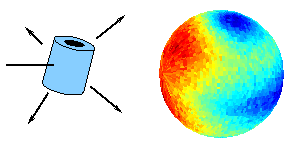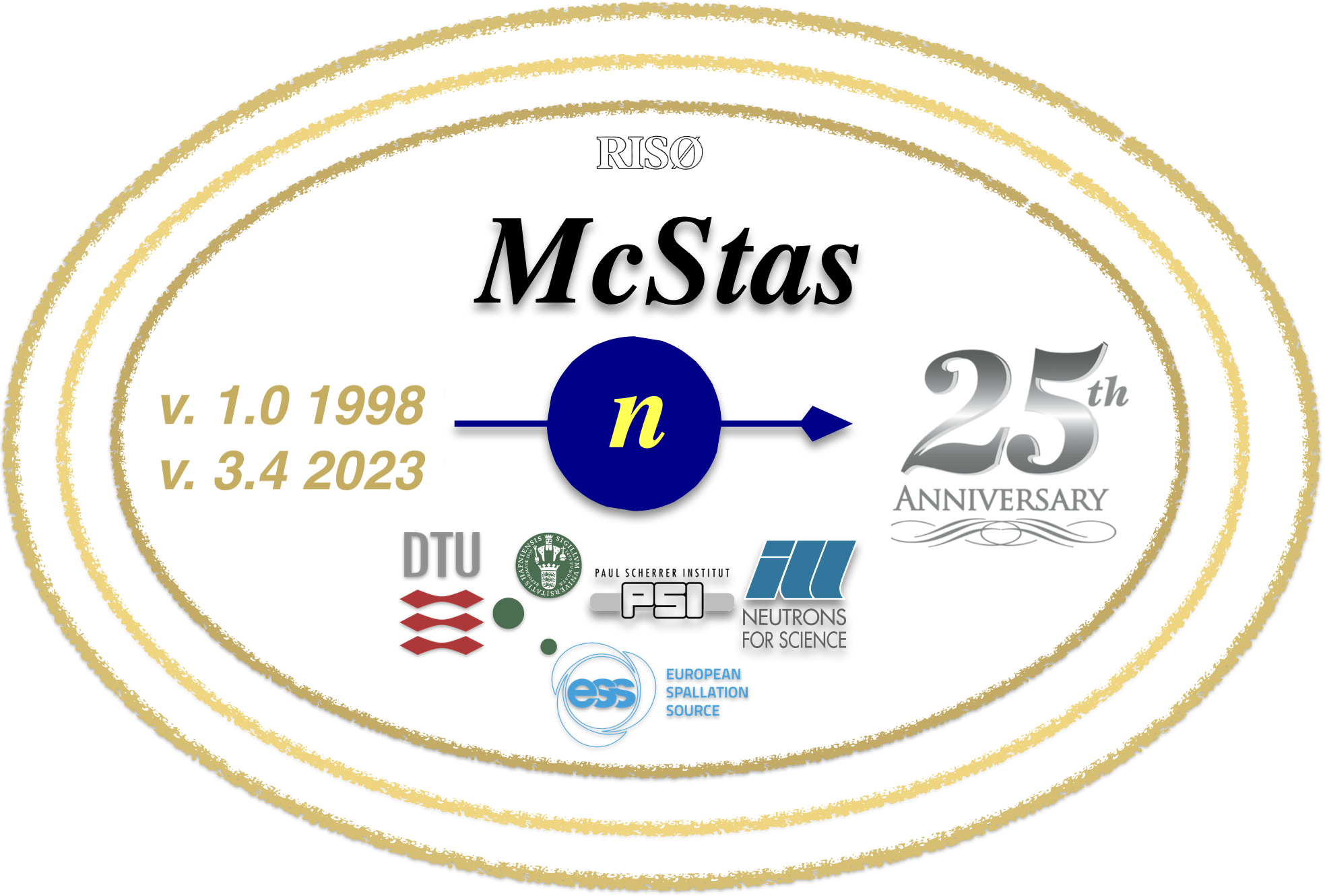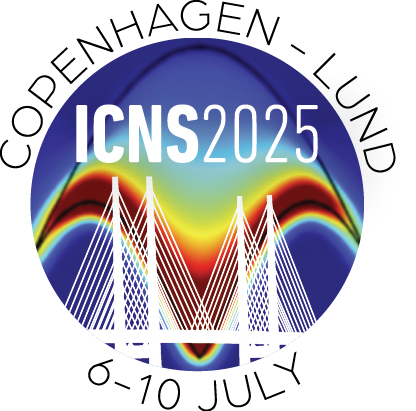 Simulated
scattering from a hollow-cylinder vanadium
sample.
Simulated
scattering from a hollow-cylinder vanadium
sample.

|
| The plot shows the intensity of scattered neutrons (red is
highest intensity). The sample is at the center of the sphere with the
neutron beam coming from the left. Clearly seen is the shadowing effect
of the sample causing a lower intensity opposite the beam. Also seen is
the effect of the non-symmetric geometry of the sample, causing lower intensity
directly above and to the side of the sample. |  |
cppcheckmcrun/mxrun simulation launch tool: (@willend)
--scan_split. Contribution from @Lomholy.cppcheck can be used to perform static code analysis on the generated code, use -C/--c-lint?NCrystal config strings. Contribution from @tkittel.mcplot/mxplot simulation plot tools: (@willend)
kill -USR2 or Progress_bar, and plots should work on an unfinished simulation.mcplot-matlab/mxplot-matlab tool is back. You need to manually install either Matlab or Octave to make use of thismcdisplay/mxdisplay instrument visualisation tools: (@willend)
conda-based installations, the mcdisplay-cad/mxdisplay-cad tool includes the cadquery dependency. On completion of building the model, the OS is asked to handle the resulting CAD model.mcdisplay-matlab/mxdisplay-matlab tool is back. You need to manually install either Matlab or Octave to make use of thismcdisplay-webgl-classic/mxdisplay-webgl-classic is used in such scenariosmcdisplay-webgl/mxdisplay-webgl based on THREE.js, react and other javascript requires a slightly time-consuming installation process on 1st launch. The user now gets an info box about this.mcdisplay-mantid IDF generator tool received a bug fix for OFF geometry detectors.mcdoc/mxdoc documentation tool: (@willend)
mctest/mxtest test tool: (@willend)
Fluorescence components have a new flag to enhance statistics/signal from low concentration materials. Work by @farhi.Union subsystem now handles 'surface physics' with the introduction of a system of refraction/reflection processes on geometry surfaces. Work by @mads-bertelsen.Union subsystem now has a functional 3D-mesh system (Union_mesh) that supports CAD style geometries. (Ascii/binary STL files and OFF files are supported. - For now only those with triangular meshing.) Work by @Lomholy.Union subsystem have been tested / improved / revised. Contributions by @tkittel and @willend in close collaboration with @mads-bertelsen.ISIS_LET by Ross Stewart and Rob Bewley, serves as test-instrument for Commodus_I3 (ISIS source model - corresponds to ViewModISIS with a different parameter interface)Multilayer_sample from Rob Dalgliesh was updated with nrepeats which allows to repeat an SLD material stack. ISIS_CRISP was updated to include this feature.TOF_PSDmonitor_toQ is a new component with built-in data reduction from Rob Dalgliesh. Uses ToF to calculate Q. Test_TOF_PSDmonitor_toQ is a basic instrument to showcase the component.conda platform which uses the
MSVC compiler is now fully functional
for all McStas code and a good part of the McXtrace code. As part of
this process a new header-file mccode-complex-lib.h
should be used by all code requiring complex numbers. (Implements
functions for e.g. +-*/ operations across platforms -
MSVC does not self implement these operations...) @willendFor all release details, please refer to the github release page for version 3.6.1
Seasons greetings from all of McStas/McXtrace - and hope you will enjoy this new release!
Peter Willendrup
INHERIT keyword in the component grammar: Allows to mix and match component sections from multiple components to achieve new functionality.
INHERIT)Full Changelog: https://github.com/mccode-dev/McCode/compare/v3.5.27...v3.5.32
Dear all,
McStas and McXtrace release 3.5.27 is now available.
McStas installation instructions are found on GitHub .
mcrun/mxrun have a new -y
switch which runs a given instrument using its default parameters.
mcplot/mxplot should now deal better with
negative / very small numbers in 'log' mode plotting.
mcgui/mxgui improved tooltips on the run dialogue.
rootmccode works with newer versions of ROOT
|P|>1.
We are now in the air with new server hardware.
Among other things this means that component mcdoc pages are back online - by popular demand!
We are in the process of upgrading the webserver for McStas, McXtrace and other sites. Please bear with us if you experience service interruptions. :-)
Dear all,
McStas and McXtrace release 3.5.24 is now available - McStas installation
instructons on GitHub .
mcgui/mxgui Let configuration dialogue spawn your EDITOR to edit your local mccode_config.json
by @willend in https://github.com/mccode-dev/McCode/pull/1838 (available also by --edit-user-config from mcrun/mxrun)mcrun/mxrun: New switch --cogen to allow on-demand switch to non-standard code generator.
See also interoperability with mccode-antlr below
by @willend in https://github.com/mccode-dev/McCode/pull/1851mcrun/mxrun Solution for picking up code generator from PATH if not found where expected
by @willend in https://github.com/mccode-dev/McCode/pull/1840mcdisplay/mxdisplay instrument line parsing
by @g5t in https://github.com/mccode-dev/McCode/pull/1834mcdisplay/mxdisplay in Windows
from @LelandWH https://github.com/mccode-dev/McCode/issues/1853Vertical_bender: Add max iteration criterion for while loop (default 1000).
by @willend in https://github.com/mccode-dev/McCode/pull/1815NCrystal_sample: Remove possible out-of-bounds memory access
by @g5t in https://github.com/mccode-dev/McCode/pull/1821Elliptic_guide_gravity and Pol_mirror: Minor comp revisions, suppresses compilation warnings from clang
by @willend in https://github.com/mccode-dev/McCode/pull/1826SNS_ARCS.instr edits
by @willend in https://github.com/mccode-dev/McCode/pull/1838ISIS_IMAT.instr DEPENDENCY " @NEXUSFLAGS@ " added
by @willend in https://github.com/mccode-dev/McCode/pull/1839Union_master Adjustment of default parameter
by @willend in https://github.com/mccode-dev/McCode/pull/1840Union-related fixes and imports from DMSC school
by @willend in https://github.com/mccode-dev/McCode/pull/1841Elliptical_guide_gravity did not work in GROUPS as it always SCATTERS
by @mads-bertelsen in https://github.com/mccode-dev/McCode/pull/1843Monitor_nD on GPU: Adjustments for coherence between CPU and GPU particle lists
by @willend in https://github.com/mccode-dev/McCode/pull/1816cl.exe: Remove variable length array allocations for issue #1817
by @g5t in https://github.com/mccode-dev/McCode/pull/1819 and
https://github.com/mccode-dev/McCode/issues/1818 by @willend in https://github.com/mccode-dev/McCode/pull/1822mccode-antlrmccode-antlr is an alternative code-generator for McStas and McXtrace - a new development by @g5t and based on ANTLR instead of lex/yacc. The new tool is mainly written in python and thus has a lower barrier for changes in language syntax and code generation. The tool implementations mcstas-antlr and mcxtrace-antlr are thus a candidate implementations to potentially replace the classic mcstas and mcxtrace code generators in the future. Current status is thatmcstas-antlr is fully feature complete wrt. mcstas for CPU simulations and close to complete for GPU simulationsmcxtrace-antlr but basic functionality is in placemccode-antlr from conda-forge or via pipmcstas-antlr by --cogen=mcstas-antlr option in mcrunMCCOGEN field of mccode_config.json using the new Save/Edit configuration in mcgui-I${MCSTAS} to prefer ingredients fromyour local library)mcrun-antlr/mxrun-antlr tools provided directly by mccode-antlr.exeinstaller from mccode.org:
Please place the MCPL-related .bat files from the extras folder in e.g. c:\mcstas-3.5.24\bin to enable MCPL
(May require giving your user 'full access' permissions to the bin folder)Full Changelog: https://github.com/mccode-dev/McCode/compare/v3.5.16...v3.5.24
Dear all,
The ICNS2025 conference is taking place in Copenhagen and Lund this summer, and the abstract submission is closing January 15th - in one week.

Of special interest to McStas users:
A satellite event is being planned for July 11th, arranged by Mads Bertelsen, ESS and Peter Willendrup DTU/ESS.
We envision a one-day event with contributed talks on instrument simulation and its use, abstract submission will open soon:
Abstract:
Neutron scattering relies heavily on computer simulations of neutron scattering instrumentation to optimize their performance. These simulation tools are also evolving to be more relevant for a running facility, aiding in both preparation and analysis for individual experiments. It is even becoming possible to make better decisions during experiments by running simulations in parallel.
All the best and hope to see you this summer in Copenhagen,
Peter Willendrup
Previous news items: 2024, 2023, 2022, 2021,2020,2019, 2018, 2017, 2016, 2015, 2014, 2013, 2012, 2011, 2010, 2009, 2008, 2007, 2006, 2005, 2004, 2003, 2002, 2001, 2000, 1999, 1998.